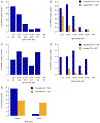Characterization of Recessive Parkinson Disease in a Large Multicenter Study
- PMID: 33045815
- PMCID: PMC8944279
- DOI: 10.1002/ana.25787
Characterization of Recessive Parkinson Disease in a Large Multicenter Study
Abstract
Studies of the phenotype and population distribution of rare genetic forms of parkinsonism are required, now that gene-targeting approaches for Parkinson disease have reached the clinical trial stage. We evaluated the frequencies of PRKN, PINK1, and DJ-1 mutations in a cohort of 1,587 cases. Mutations were found in 14.1% of patients; 27.6% were familial and 8% were isolated. PRKN was the gene most frequently mutated in Caucasians, whereas PINK1 mutations predominated in Arab-Berber individuals. Patients with PRKN mutations had an earlier age at onset, and less asymmetry, levodopa-induced motor complications, dysautonomia, and dementia than those without mutations. ANN NEUROL 2020;88:843-850.
© 2020 American Neurological Association.
Conflict of interest statement
Potential Conflicts of Interest
Nothing to report.
Figures


References
Publication types
MeSH terms
Substances
Grants and funding
LinkOut - more resources
Full Text Sources
Medical
Miscellaneous

